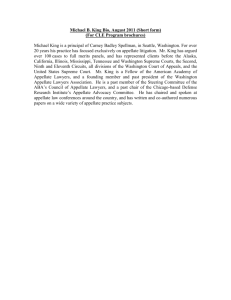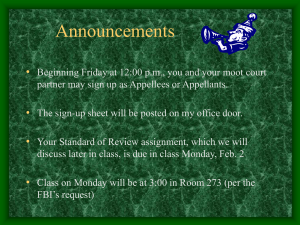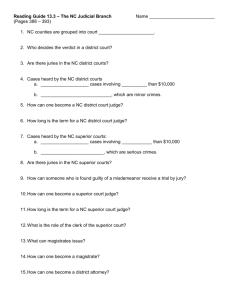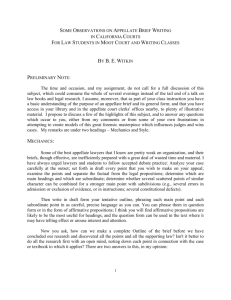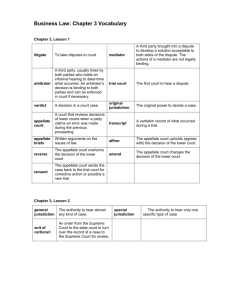post-reading exercise - Legal Writing Institute
advertisement
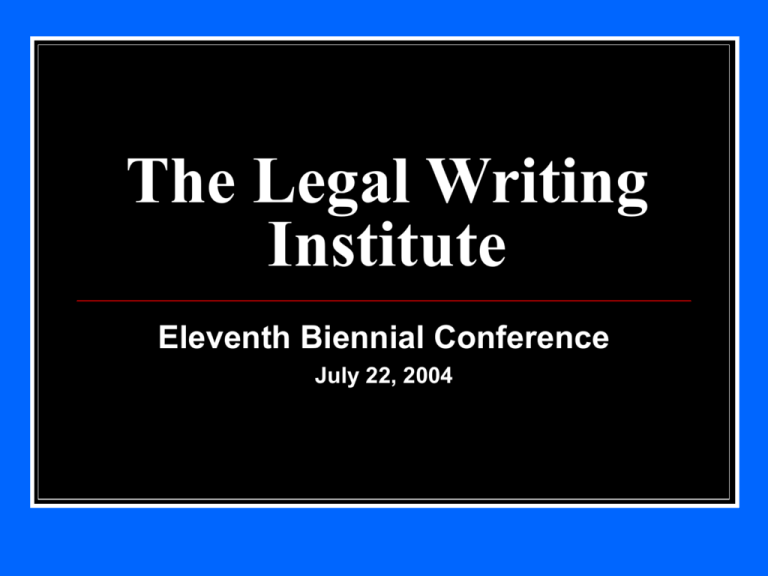
The Legal Writing Institute Eleventh Biennial Conference July 22, 2004 In a Case, In a Book, They Will Not Take a Second Look! Critical Reading in the Legal Writing Classroom Nova Southeastern University Shepard Broad Law Center I. What is Critical Reading? Creating “meaning within the text” Making analytical judgments about reading Determine additional information needed for informed understanding (not just memorization) of written text Relating written text to post-reading exercises, both objective and subjective II. Why Teach Critical Reading in LRW? Core Lawyering Skills: Critical reading skills Analytic, critical thinking and problem solving skills Writing skills Verbal communication skills Listening skills Correlation to Student Performance Correlation between poor critical reading skills and: Poor performance on legal writing assignments – critical reading ability influences analytic, critical thinking, problem solving, and writing skills Poor performance on traditional multiple choice questions Poor performance on analytical examination questions III. Critical Reading Process: Four steps to read efficiently and proficiently A. Place material to be read into context. • • B. C. D. Determine why material is being read -What is the purpose of the material within the class or subject being approached? Use other parts of reading material to determine context (table of contents, chapter headings, definitions for unknown words) Skim material Actively read material, taking notes, looking up words and concepts for basic understanding Complete post-reading exercise to confirm understanding IV. Classroom Strategies Teaching students to read efficiently and proficiently A. Pre-reading Techniques: Context 1. Discuss the reason that the material exists, the source and who created it 2. Discuss different ways information could have been presented or is available to reader 3. Understand where reading materials fits with course or subject matter objectives 4. Gather information to prepare for active reading IV. Classroom Strategies Teaching students to read efficiently and proficiently B. Reading Techniques: Skimming 1. Students skim material to get overview/overall sense of material 2. Encourage multiple reviews of material at different depths C. Reading Techniques: Active Reading 1. Students read and annotate material 2. Focus on content and language of text 3. Students clarify unknown meanings with resources 4. Students annotate by underlining, questioning and outlining material, including briefing IV. Classroom Strategies Teaching students to read efficiently and proficiently D. Post Reading Techniques Reinforce understanding through objective examination and subjective written exercises a. b. c. d. Summarize Evaluate Synthesize Hypothesize Goal of critical reading is to make material CLEAR Claims: Logic: What are the claims and issues? Is presentation/organization logical? Evidence: Do facts support the argument? Analysis: Is analysis sound and based on legal reasoning? Are there counter-arguments and counter-evidence? Rebuttal: THE ZAX By Dr. Seuss A. Place material to be read into context. A. Goal of reading: Learning critical reading techniques by reading 1961 Dr. Seuss story B. Skim passage to be read. B. Skim story C. Actively read passage, taking notes, looking up words and concepts for basic understanding. C. Define – What is a Zax? D. Post-reading exercise. D. Objectively—what happened? Subjectively—what if?????? What is “north going” and “south going?” Look for theme of story, key facts, reason for outcome Question: Does the world stand still when Zax(es?) refuse to move out of each other’s way? Answer: No. The world did not stand still when the Zax refused to move. Analysis: Rules Facts: Objective and Subjective Evaluation: North going Zax travel north South going Zax travel south Zax will not move when asked Zax will not step to the side east or west and will stand in a spot for 59 years rather than move in a different direction Zax will not budge when path is obstructed North going Zax and South going Zax came face to face . Neither would move out of each other’s way so the other could pass. A road was built over them Objective: WHAT HAPPENED (here) Subjective: What happens when the north going Zax reaches the North Pole and the south going Zax reaches the South Pole? Dowdell v. Bloomquist A. Place material to be read into context. A. Learning critical reading techniques by reading case. Complete remaining critical reading steps in groups. B. Skim passage to be read. B. Skim case. C. Actively read passage, taking notes, looking up words and concepts for basic understanding. C. Define – unknown terms (such as “private nuisance”) Annotate key facts, rules, outcome. Case briefing is also actively reading. D. Post-reading exercise. D. Objective: Evaluate what happened? (through objective measures) Subjective: Hypotheticals— expository writing Objective Post-Reading Exercise: Dowdell 1. How did the appellate court treat the trial court’s version of the facts? a. In making its decision, the appellate court did not use the trial judge’s version of the facts because an appellate court always takes a new look at the facts and determines the credibility of witnesses who testified. b. In making its decision, the appellate court did not use the trial judge’s version of the facts because there was proof that the trial court overlooked material evidence. c. In making its decision, the appellate court used the trial judge’s version of the facts because there was no proof that the trial judge misconceived or overlooked evidence and the appellate court deferred to the trial judge’s determination of the credibility of witnesses who testified. d. In making its decision, the appellate court accepted the trial judge’s version of the facts because an appellate court always accepts a trial judge’s factual findings. Objective Post-Reading Exercise: Dowdell 1. How did the appellate court treat the trial court’s version of the facts? a. In making its decision, the appellate court did not use the trial judge’s version of the facts because an appellate court always takes a new look at the facts and determines the credibility of witnesses who testified. b. In making its decision, the appellate court did not use the trial judge’s version of the facts because there was proof that the trial court overlooked material evidence. c. In making its decision, the appellate court used the trial judge’s version of the facts because there was no proof that the trial judge misconceived or overlooked evidence and the appellate court deferred to the trial judge’s determination of the credibility of witnesses who testified. d. In making its decision, the appellate court accepted the trial judge’s version of the facts because an appellate court always accepts a trial judge’s factual findings. This question is procedural in nature and tests the student reader’s understanding of the appellate court’s role as reviewer. It provides a basis for an in-class discussion on the relationship between trial courts and appellate courts. Objective Post-Reading Exercise: Dowdell 2. What question was the appellate court asked to decide? a. Did the row of trees block the property owner’s view of the ocean? b. Could the row of trees constitute a “spite fence” or structure? c. Was the value of the property decreased by the row of trees? d. Was the property owner entitled to a zoning variance to build a second story addition to his home? Objective Post-Reading Exercise: Dowdell 2. What question was the appellate court asked to decide? a. Did the row of trees block the property owner’s view of the ocean? b. Could the row of trees constitute a “spite fence” or structure? c. Was the value of the property decreased by the row of trees? d. Was the property owner entitled to a zoning variance to build a second story addition to his home? This question tests the student reader’s ability to pick out the issue in the case. Objective Post-Reading Exercise: Dowdell 3. Which of the following is correct? a. The appellate court disapproved of the outcome of the case at the trial court level and disagreed with the trial court’s reasoning. b. The appellate court disapproved of the outcome of the case at the trial court level but agreed with the trial court’s reasoning. c. The appellate court approved of the outcome of the case at the trial court level but disagreed with the trial court’s reasoning. d. The appellate court approved of the outcome of the case at the trial court level and agreed with the trial court’s reasoning. Objective Post-Reading Exercise: Dowdell 3. Which of the following is correct? a. The appellate court disapproved of the outcome of the case at the trial court level and disagreed with the trial court’s reasoning. b. The appellate court disapproved of the outcome of the case at the trial court level but agreed with the trial court’s reasoning. c. The appellate court approved of the outcome of the case at the trial court level but disagreed with the trial court’s reasoning. d. The appellate court approved of the outcome of the case at the trial court level and agreed with the trial court’s reasoning. This question is procedural in nature and tests the student reader’s understanding of the result of the case. It provides a basis for an in-class discussion about court decisions. Objective Post-Reading Exercise: Dowdell 4. Which of the following is not a true statement? a. The statutory definition of a lawful fence includes a hedge. b. A fence that is maliciously erected to annoy an adjoining landowner may be enjoined as a private nuisance under the “spite fence” statute even though it only interferes with a property owner’s light and view. c. A fence that is maliciously erected to annoy an adjoining landowner will not be enjoined as a private nuisance under the “spite fence” statute if it is erected in part for a useful purpose. d. A four foot fence that is maliciously erected to annoy an adjoining landowner can be enjoined as a private nuisance under the “spite-fence” statute. Objective Post-Reading Exercise: Dowdell 4. Which of the following is not a true statement? a. The statutory definition of a lawful fence includes a hedge. b. A fence that is maliciously erected to annoy an adjoining landowner may be enjoined as a private nuisance under the “spite fence” statute even though it only interferes with a property owner’s light and view. c. A fence that is maliciously erected to annoy an adjoining landowner will not be enjoined as a private nuisance under the “spite fence” statute if it is erected in part for a useful purpose. d. A four foot fence that is maliciously erected to annoy an adjoining landowner can be enjoined as a private nuisance under the “spite-fence” statute. This question tests the student reader’s ability to carefully read text and the rules of law. Objective Post-Reading Exercise: Dowdell 5. On which of the following facts did the appellate court rely to support its ruling? I. Defendant applied to the zoning board for approval to build a second-story addition to his house and Plaintiff voiced her objection to the addition. II. Western arborvitae is not a hedge plant. III. Defendant planted trees on the property line a day after the zoning board heard arguments on his request for zoning approval to build a second story addition to his home. IV. The trees Defendant planted on the property line grew 45 feet tall and 60 feet across. V. The trees Defendant planted on the property line provided his home with privacy. a. b. c. d. III only II and V I, III, and IV All of the above Objective Post-Reading Exercise: Dowdell 5. On which of the following facts did the appellate court rely to support its ruling? I. Defendant applied to the zoning board for approval to build a second-story addition to his house and Plaintiff voiced her objection to the addition. II. Western arborvitae is not a hedge plant. III. Defendant planted trees on the property line a day after the zoning board heard arguments on his request for zoning approval to build a second story addition to his home. IV. The trees Defendant planted on the property line grew 45 feet tall and 60 feet across. V. The trees Defendant planted on the property line provided his home with privacy. a. b. c. d. III only II and V I, III, and IV All of the above This question tests the student reader’s ability to connect the facts to the court’s reasoning. It provides a basis for an in-class discussion on the relationship between facts and law. Subjective Post-Reading Exercise: Dowdell Use the case of Dowdell v. Bloomquist and the rules of law discussed in that case to answer the following question: Limit your discussion to one page. If a landowner connected a ten-foot rope to two seven foot poles, to erect a clothesline on his property line, could the clothesline be enjoined as a private nuisance under the Rhode Island “spite-fence” statute if an adjoining homeowner’s view of the mountains was obstructed whenever clothes were hung on the line to dry? This is an example of a follow-up exercise which tests the student reader’s ability to apply what he/she has read to a different set of circumstances. V. Summary: Classroom Methodologies Practice, Practice, Practice - Critical reading opportunities in every class Variety of sources – books, stories, newspaper and magazine articles, poems, cases, statutes Use short passages Group work/interactive cooperative learning Teacher as facilitator VI. Bibliography Lorraine K. Bannai and Marie Eaton, Fostering Diversity in the Legal Profession: A Model for Preparing Minority and Other Non-Traditional Students for Law School, 31 U. S. F. L. Rev. 821 (1997) Paul Beneke, Start with Enacted Law, Not Common Law, 10 Persp. 76 (Spring 2002) Richard Cabrera, Essay: Working to Improve: A Plan of Action for Improving the Bar Exam Pass Rate, 27 Wm. Mitchell L. Rev. 1169 (2000) Peter Dewitz, Reading Law: Three Suggestions for Legal Education, 27 U.Tol.L. Rev. 657 (1996) Peter Dewitz, Legal Education: A Problem of Learning from Text, 23 N.Y.U. Rev. L. & Soc. Change 225, 230 (1997) Barbara Glesner Fines, Preparing for Class, available at http://www.law.umkc.edu/faculty/profiles/glesnerfines/Success2.html (visited June 1, 2004) Keith Kemper, Freedom of Religion vs. Public School Reading Curriculum, 12 Seattle U. L. Rev. 405 (1989) Critical Reading Skills Sheet, compiled by Craig M. Klugman, www.unr.edu/homepage/cmk/cread.htm (visited June 1, 2004) Inservice Activities, available at http://www.msit.gsu.edu/balancedinstruction (visited July 18, 2003) Greg Sergienko, New Modes of Assessment, 38 San Diego L. Rev. 463 (2001) Nirvi Sha, Revised SAT to Have New Writing Section, Palm Beach Post, May 31, 2004, at C1. Chitra Varaprasad, Some Classroom Strategies: Developing Critical Literacy Awareness, 35 Eng. Teaching Forum Online 24 (July-Sept. 1997)
